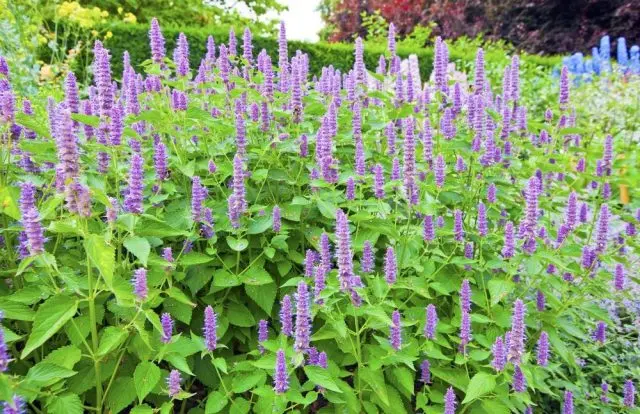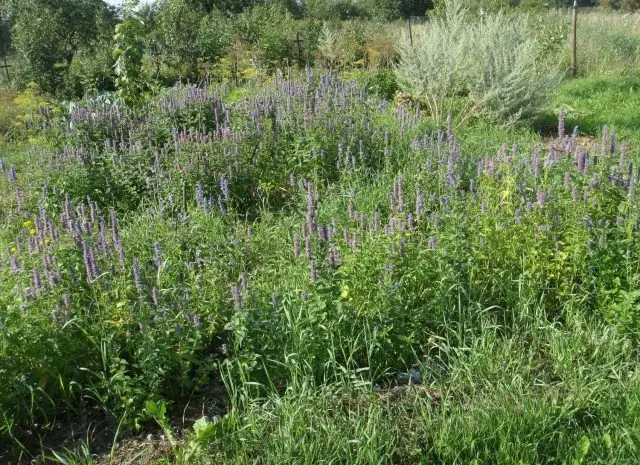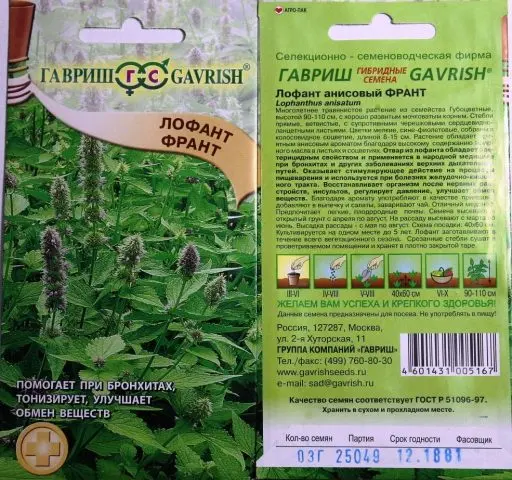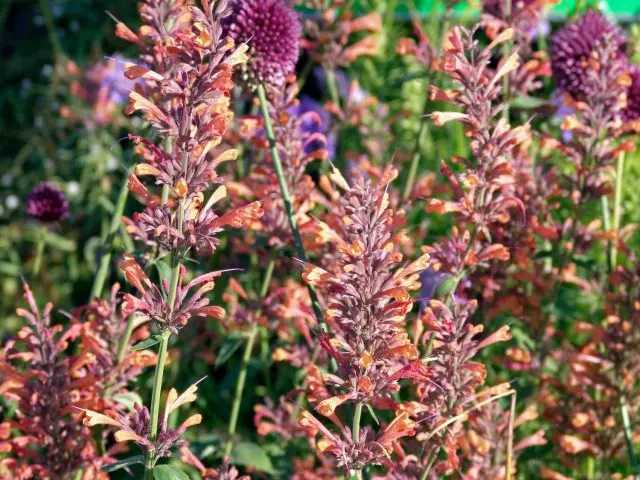Contents
The lofant plant is unique in its healing properties and chemical composition; it is not for nothing that it is called northern ginseng. Tibetan monks have used it since ancient times in their recipes to treat a wide range of ailments. Today, the lofant is also grown for decorative purposes and as a honey plant. The popularity of this crop among gardeners is growing year by year.
Characteristics of the lofant plant
Lofant (multi-grill) is a herbaceous perennial from the Lamiaceae family. The genus unites 22 species with similar morphological characteristics. In different regions, the plant is known by the following names:
- licorice mint;
- large blue hyssop;
- fennel multi-grate (fennel);
- гrebnetsvet anise;
- hyssop giant;
- hyssop anise;
- agastache (agastachis).
The Latin name of this genus of herbs – Agastache, consists of 2 words of Greek origin: agan – “many, many”, and stachys – “ear”. Many English-language sources refer to the polygon simply as mint because of the characteristic spicy aroma and the similarity of flowers and leaves.
The natural habitat of this medicinal plant is the Northern states of the USA, the Southern regions of Canada, Asia. Nowadays, in the wild, none of the lofant species is practically found. The first description of agastahis belongs to a botanist from Holland – Jan Gronovius. In 1762, using only a few specimens and notes from John Clayton, an English collector of Virginia flora, he was able to give a detailed description of the genus of polygons he was studying.
The lofant plant is a shrub with several straight, tetrahedral stems bearing opposite, serrated, simple leaves. The height of the multi-grate, depending on the variety, ranges from 45-150 cm, the diameter of an adult plant is up to 90 cm.
The top of each shoot is crowned with a complex vertical inflorescence in the shape of a candle. The calyx of the flower has a tubular conical shape, the corolla is also tubular, gradually expanding. The flower has 4 stamens, 2 of which are longer, the pistil has 2 stigmas. The color of the petals can vary from pink and lilac to deep purple. The ripened fruit is divided into 4 smooth nuts with villi in the upper part.
Like many other plants of the family, lofant has a pleasant aroma. In the midst of flowering in calm weather, the gentle notes of the lofant fill the entire garden with fragrance. Essential oils are found in abundance not only in the flowers, but also in the leaves of the plant, and when lightly rubbed, they also exude a delicate anise aroma.

Lofant is a valuable honey plant. Along with sweet clover, this plant is specially sown to collect honey, which has an interesting anise flavor. Beekeepers love the polygon for its unpretentiousness and long flowering period. Lofant can be grown in one place for up to 10 years, provided that the climate does not differ in particularly severe frosts.
Useful properties of grass lofant
Lofant is a medicinal plant, which many rightly consider one of the best natural biostimulants. In folk medicine, a polygon is used for:
- acute respiratory diseases;
- diseases of the gastrointestinal tract;
- diseases of the urogenital area.
The powerful medicinal properties of lofant herb have been scientifically proven. The tool is used as:
- anti-inflammatory;
- antimicrobial;
- antioxidant;
- antifungal;
- lipotropic;
- immunostimulating.
Description of varieties and types of lofant
Many species and bred varieties of lofant are successfully grown on household plots both in our country and abroad. Plants differ in the size of the bush, decorativeness and the degree of honey production, however, all polygons have powerful medicinal properties.

Lofant Mexican
This type of polygon is loved by many flower growers because of the compact size of the bush and large bright inflorescences. The plant in adult form does not exceed 80 cm in height, while the ear reaches half the total length of the stem. It blooms with rich red or pale pink flowers, exuding a delicate aroma.
The Mexican lofant is a plant with good drought tolerance and grows well even in poor soils. This type of polygon is not grown as a honey plant because it is unattractive to bees. The plant is often used in landscape design for landscaping the local area, it is well formed through regular pinching.
The most popular variety of Mexican mint (lofanta) is Amethyst. This is a fairly tall plant, the bush reaches a height of 1,5 m. It is valued as a good honey plant; for medical purposes, the Mexican polygon is used to remove toxins, toxins and radioactive substances. It helps to normalize blood pressure, prevent blockage of blood vessels, improve metabolism, as well as headaches and insomnia.

Lofant wrinkled
Lofant Tibetan or wrinkled is often called Korean mint due to its wide distribution in this country. In addition to Korea, this plant can be found in the Himalayas and Tibet, in Central and North Asia, in Siberia. This type of multi-grate grows especially well on drained sandy and sandy loamy soils.
The plant is a cross between a shrub and grass. The species reaches a height of 1 m, in diameter – up to 60 cm. The leaves look like nettles, the inflorescences are dense candles with many small funnel-shaped purple-violet flowers. Korean mint has a pronounced anise flavor that attracts a large number of insects. From 1 hectare planted with wrinkled lofant, a beekeeper can collect up to 700 kg of tasty and healthy honey per season.
This type of multi-grate has good frost resistance. The rhizome of the Tibetan lofant does not freeze at -30°C, the ground part can endure a short-term drop in temperature to -5 … -10°C.

Lofant Frant
Anise lofant Frant is a perennial plant growing up to 110 cm in height. The flowers of the polygon are painted in blue-violet tones, dense spike-shaped inflorescences reach a length of 8-15 cm. Seeds of this species can be purchased at many hypermarkets or via the Internet. It can be sown both in open ground and for seedlings.
Lofant Frant blooms throughout the summer season, new ones quickly bloom to replace dried flowers. This variety does not differ in an enviable decorative effect, but gardeners fell in love with its unpretentiousness, valuable medicinal properties and a pleasant aroma, somewhat reminiscent of mint and valerian.

Lofant Barbera
This type of multi-grate is distinguished by its compact size (height no more than 60 cm) and bright orange color of flowers. The foliage has a gray-green tint. Lofant Barbera grows wild in the southeastern United States and northern Mexico. The plant prefers sunny areas, does not tolerate frost.

Lofant mountain
This type of agastakhis is characterized by compactness and increased tillering. The mountain lofant grows on average up to 45-90 cm. The aroma of flowers is stronger than that of the wrinkled polygon. The plant is grown mainly as an annual, but in central Our Country and more southern regions, with good shelter, it can successfully overwinter. The most popular varieties are:
- Desеrt Sunrise (tall bush with pink flowers);
- Sunset (lilac-orange inflorescences, bush – about 50 cm in height);
- Blazing Sunset (with a characteristic mint aroma).

Planting and caring for a lofant in the open field
Lofant is an unpretentious plant that can grow on any type of soil. It will not die on acidic and swampy soil, however, it will bloom poorly and rarely.
On fertile nutrient soils, the lofant will grow quickly and show itself in all its glory. Systematic pruning will stimulate the development of new shoots and provide an extended flowering period of several months.
During the dry season, the plant needs regular watering. For abundant flowering, the multi-grate should be fertilized regularly. To increase the decorative effect, complex mineral fertilizers are used, which are applied 3 times a season, in the fall they are fed with organic matter (compost or humus).
As weeds grow, lofant thickets need to be weeded, as the plant is not able to displace more aggressive species. In autumn, many gardeners cut off the ground part of the plant, leaving half of the total height of the bush.
Reproduction
Lofant can be propagated both vegetatively and generatively. The most common breeding methods are:
- Division of the bush. In early autumn or early spring, before the appearance of new shoots, the adult multi-grate bush is divided into 3-5 parts so that each has a well-developed root system. Delenki are immediately determined to a new place, having previously placed drainage in the hole, and watered abundantly after planting.
- Cuttings. Shoots are rooted similarly to any garden shrubs in a nutrient substrate, providing high humidity, that is, placing in a greenhouse or greenhouse.
- Seed method. Growing a lofant from seeds is one of the most popular breeding methods. Seeds are sown directly into the ground in early May, after the last frost. To do this, grooves are made about 2 cm deep, where the prepared planting material is placed. For better germination, seeds can be soaked in a growth stimulant solution. As young plants germinate, plantings are thinned out, leaving stronger and more viable.
- Seedling method. Lofant seeds are sown in large containers in early April. After the appearance of 2 pairs of true leaves, the plants dive into separate pots. In the spring, after the last frost, the seedlings are determined to a permanent place. With this method of reproduction, the flowering of the polygon occurs in the first season.
Diseases and pests
Any type of lofant is resistant to most diseases and is practically not affected by pests. In the case of prolonged wet and cool weather, as well as with a strong thickening of plantings, the plant may suffer from powdery mildew, fusarium and spotting. These diseases are of fungal origin and are eliminated through the use of fungicides. The plant is sprayed with a preparation diluted according to the instructions in 2 stages with an interval of a week.

When the lofant is collected
Raw materials are harvested from the last days of June to August. For a season, 1 crops can be harvested from 2 plant. Collection is best done in hot weather, since it is in such conditions that the concentration of nutrients in the ground part is maximum. The shoots are cut from the bush with a sharp blade at a height of 10-12 cm, the foliage can be cut off with your hands.
How to properly dry a lofant
The multi-grate is dried in a dark, well-ventilated room, tied into small brooms and hung on a rope or wire.
The dried lofant is crushed and stored in a tightly closed glass container. Shelf life – up to 2 years.
How to use a lofant
The lofant plant is widely used in medicine. Agastahis is an ingredient in many commercially produced drugs. In folk recipes, anise polygon is even more common. The most popular ways to use a lofant:
- With minor damage to the skin and fungal diseases, baths from a decoction of lofant grass help well.
- In the form of compresses, lotions, multi-grate tinctures are used for vascular diseases of the legs. The tool removes puffiness well.
- In case of heart diseases, the use of a lofant can reduce the risk of stroke, stabilize blood pressure, and strengthen the walls of blood vessels. In order to prevent drugs based on it are prescribed for ischemia.
- Thanks to its powerful sedative effect, the polycodium has a beneficial effect on brain function, especially in senile sclerosis.
- With parkinsonism, lofant is used as often as rosehip root, angelica or sage. Tincture of crushed leaves, stems and inflorescences on alcohol allows you to get rid of the disease as soon as possible.
- The lofant plant is a strong antioxidant. It is used to remove toxins and toxins from the body, as well as in case of severe poisoning.
- Reception of a decoction from a multi-grate normalizes metabolism.
- As a restorative agent, lofant is used after suffering pulmonary diseases, including pneumonia and bronchitis.
Противопоказания
Despite the proven medicinal properties, the lofant also has contraindications. In addition to individual intolerance to the substances that make up the chemical composition of the plant, it is not recommended to take it in the following cases:
- with low blood pressure;
- during pregnancy and lactation;
- in the postoperative period;
- in the presence of oncology;
- in thrombophlebitis;
- with epilepsy.
The consequences of an overdose of anise lofant can also be deplorable. Despite the seeming harmlessness of drugs based on lofant, it is better to consult a doctor before use, since only a specialist can calculate the correct course of treatment based on the individual characteristics and predispositions of the patient.
Conclusion
The lofant plant will not only decorate any garden, but also a green healer that helps with many diseases. Even an inexperienced grower can grow a lofant due to the unpretentiousness and vitality of the plant.









